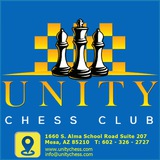If 25...Qd7 26.Rxd7+ Bxd7, White has many attacking resources, one of which is 27.Bc3 Re8 28.Qd2, with the threats of g2-g4 and Qd2-g5, and a decisive attack on the dark squares.
Unity Chess Club
Lev Polugaevsky Joaquim Durao Lugano ol 1968 White to move
It may appear that Black has chances of a kingside attack, but this is not so. The pawn center d4-e5 solidly protects the squares that Black might want to use to bring up additional resources to the kingside. Even so, White has to hurry, because Black plans to bring his knight via f8 to g6, and then play ...Bd7 and ...Raf8. If he manages this, he will stand very well. But White finds a serious defect in Black’s position, namely the poorly-defended Ng4, and he attacks it:
An open attack on the Ng4. Now, Black is simply lost, because he has to exchange queens.
Or 19...Rg5 20.f4 Nh4+ 21.gxh4 Ne3+ 22.Kf2 Ng4+ 23.Ke1 (23.Kg3+–) 23...Qxh4+ 24.Kd1 Rg6 25.Kc2+–.
23...Nf5 24.Rc2 Nf8 25.Bc1 g5 26.g4 Nh4+ 27.Kg3 Nxf3 28.Nxf3 Rh6 29.Bxg5 Bxg5 30.Nxg5 Rg6 31.f4 Bc6 32.Rh1 a5 33.Bf1 h6 34.Nf3 Kh7? 35.Bd3 1-0
Unity Chess Club
Bent Larsen 2620 Boris Spassky 2630 Tilburg 1978 White to move
If the rook is allowed into e2, Black gets counterplay. But it turns out that White can not only defend but also counterattack:
It turns out that because of the small number of flight squares for the black king, Black must retreat his rook along the 8th rank, after which White has a decisive material advantage.
It cannot be said that the move chosen in the game, 46...Rg8, caused White any real problems: 47.Ne6+ Kf6 48.Nxc5+ Ke5 49.Rh6 Kf4 50.Rxh4+ Ke3 51.Ne4! fxe4 52.Rxe4+ Kd2 53.Kf2, and Black resigned.
